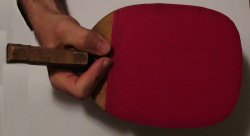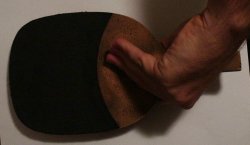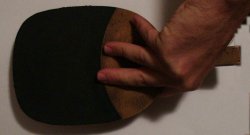
This grip is similar to the traditional Chinese penhold grip, but the fingers on the back of the bat are extended straight out rather than curled.
The two most common variations are shown in the photographs, with the main difference between the position of the fourth and fifth fingers. In one variation they are kept close together with the third finger, and in the other variation they are spread out on the back of the blade.
Advantages
The extending of the fingers on the back of the racket adds to the power that can be generated from the forehand side, and this grip is also good for forehand strokes.
The wrist can move quite freely in the direction of the left edge of the blade to the right, and vice versa, which will allow good spin to be generated from the forehand side, and when serving.

Disadvantages
The movement of the blade from the handle to the top of the bat is somewhat restricted by the extended fingers. This makes adjusting the angle of the bat more difficult on the backhand side. It is also difficult to hit a consistent backhand topspin with this grip, although several professional players have mastered this stroke.
This grip also has a restricted reach on the backhand side, making it necessary for players to cover more of the table with their forehand side, requiring fast footwork and good stamina.
What Type of Player Uses This Grip?

Similarly to the traditional Chinese Grip, this grip is favored by those players who prefer to attack with the forehand. Players who use this grip tend to play a little further back from the table than users of the traditional Chinese penhold grip, using fast topspin loops with their forehand and blocks or fishes with the backhand. They rely on their speedy footwork to allow them to hit their powerful forehand as often as possible.
A search through the ranks of top players over the last 30 years would struggle to find a single defender that used this grip.

